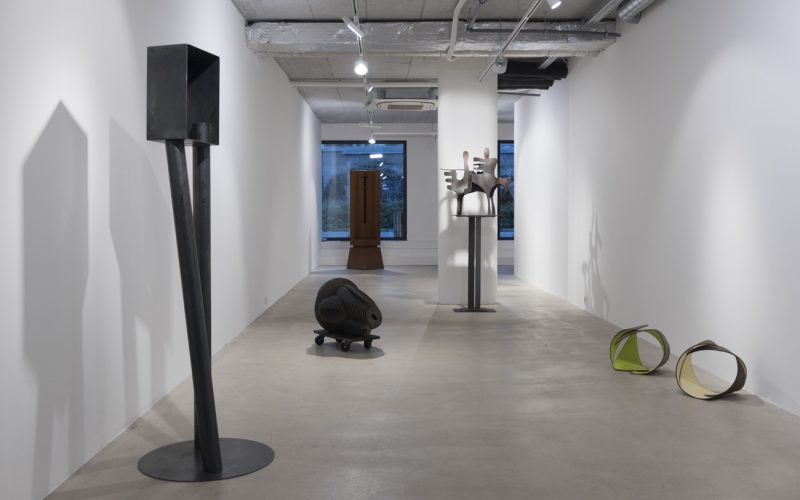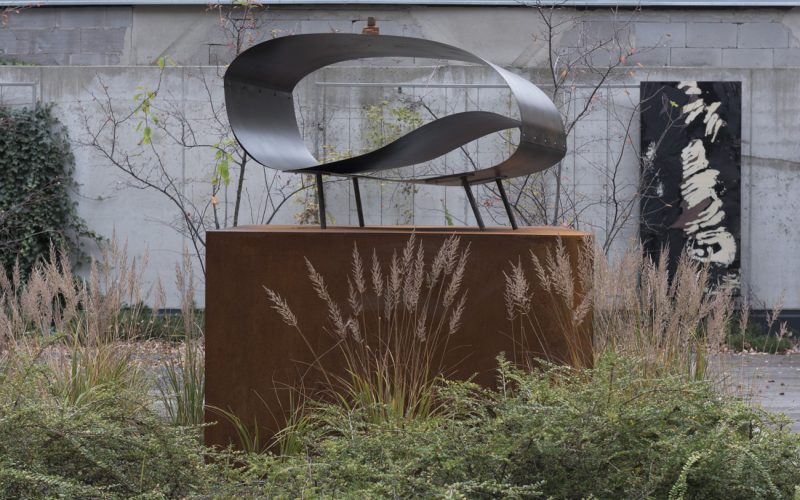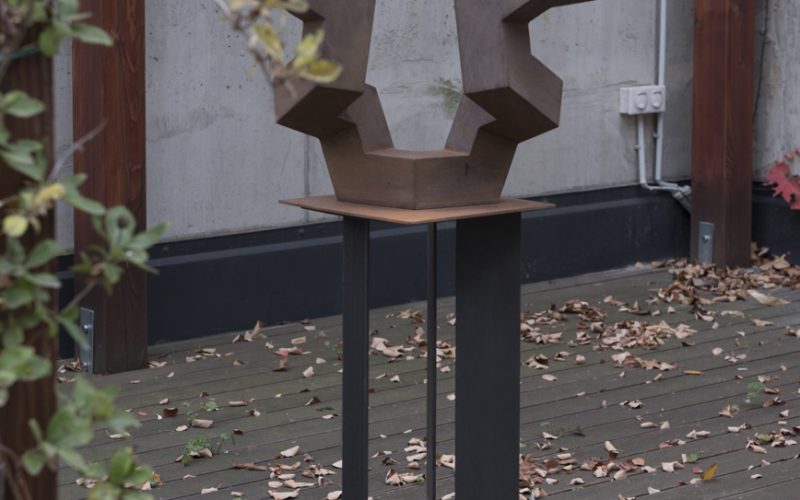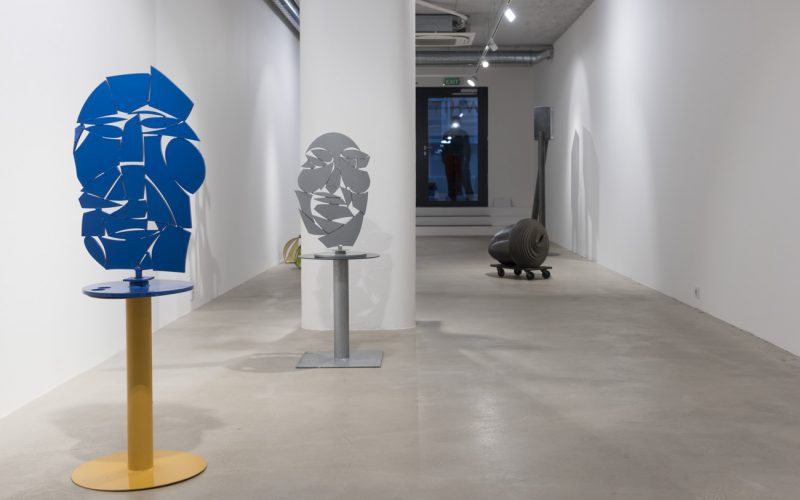23 OCT - 23 NOV 2018
S_culpture E_NERGy M_ATERIal
Martti Aiha/FI, Petr Císařovský/CZ, Kurt Gebauer/CZ, Roland de Jong/NL, Martin Kocourek/CZ, Katarína Kissoczy/SK/CZ, Erna Masarovičová/SK, Peter Roller/SK, Matej Rosmány/SK, Jiří Šorm/CZ, Dionýz Troskó/SK, Eelke van Willegen/NL
In the beginning of the time span captured by this overarching exhibition were two names – the names of two artists who have spent a substantive part of their art life working with metal, be it in the form of metal jewellery or a monumental version that continues to enrich and fill out public spaces. The mother and daughter, Erna Masarovičová and Katarina Kissoczy,represent a unique combination of originality, invention and energy. Simultaneously they convey a story of cognition, recognition, respect and proof of immense energy and fulfilled goals.
Erna Masarovičová was undoubtedlyone of the most distinctive representatives of modern Slovak art of 1960s through 1980s. Art historians consider her one of the outstanding figures in the founding generation of modern Slovak sculpture. In both areas of her work – jewellery and large-scale art works – she was the kind of artist who slammed the door on the rudiments of primitive realism demanded in service to the totalitarian regime. She used her work to unmask and depict the ambivalence of our action and existence in those conflicting times, expediently supported by utilizing metal – her preferred material. Metal gives Erna’s works a hard form of sharing, confirmed by its structure and flamboyance. The majesty of her adaptation not only induces admiration but also validates the final impact. She developed and put in place a technique of welding and cutting steel sheets.
All this unfolded in the very suggestive and inspiring environment of her own studio and house built by Masarovičová and her husband with their own hands during the storied 1960s, nowadays frequently mentioned for the temporary cultural and political relaxation, which aptly brings us to Katarina Kissoczy´s amiable memory of those times: “My parents – mother as a sculptor and father as a mechanical engineer with ambitions to be an architect – managed to create an environment with completely unique atmosphere from today´s perspective. The house in Bratislava with my mom´s studio, with annual sculpture symposiums organized there, was “hand-made”, because it was impossible to find building materials back in 1964–1967. For instance, I remember it was impossible to buy bricks at that time and my parents had to get used ones. What counted for more back then, however, was craftmanship and innovation.”
The house plays a key role in the whole story since it not only links the physical space where art works were and are created. The time gap is also of essential importance. While the mother Ester worked here between 1967-2008, her daughter Katarina already started to use the studio in 1984. In her art work she uses metal waste, and she welds, cuts and bends the materials, moreover introducing new colourfulness and humor to her works. It should be noted that Katarina continues to use the same tools all the time, often incorporating remnants of materials from her mother´s works into her art. Considering the materials used and the proportions of her works, they are mostly designed for exteriors.
This time lapse in using the studio, which in itself is actually an outstanding sculpture and piece of architectural design has helped Katarina Kissoczy to promote an appreciation and recognition of the quality and power in her mother´s work, and actually initiated an artistic dialogue between the two artists. The daughter has brought this message to life by establishing the international symposium SEM, noworganized for the tenth time. The symposium has very clear goals – to carry on and further develop work with metal in both areas – in both small-scale and monumental form. This concept is clearly inspired by the works of both artists. Katarina selects symposium guests and curators along these lines. From the very start she has also made the event international – a number of Czech artists along with authors from Germany, Poland, Finland, the Netherlands, Great Britain, the United States of America, France and other countries have participated in the SEM symposium. There is always a fine balance of sculptors and jewellers in the artist teams, with one place offered to a painter, and Katarina not only provides them with material for their work, over about twelve days of artistic creation in the studio, but also technological assistance when needed. Famous Slovak photographers and filmmakers are among the project’s long-term collaborators, documenting it and thus creating their own works.
Ten years of existence are proof of the vitality of the endeavour, and its rationale, quality and perseverance. The persistence, stubbornness and diligence of Katarina Kissozy and her closest coworkers has helped to make a place for the Symposium in the Slovak, Bratislava and Czech scenes of visual arts. This original project, illustrating the possibility of a free creation and presentation process that is not subject to corrections and directions, continues to exist without any turmoil.
Two years ago, in my speech opening an exhibition art work created during the SEM Symposium’s eighth year, I compared the work of Katarina Kissoczy to the work of Peggy Guggenheim, a collector, bohème and philanthropist in Venice. The same Mediterranean days and evenings, and an almost Venetian atmosphere – all of this has repeated itself this year. Even so, one evening Katarina whispered: No man ever steps in the same river twice. I wanted to strongly object to the use of this ancient statement – Katarina reenters the same river repeatedly, and in fact for the tenth time this year! Indeed she not only enters it, she actually swims in it, obviously with great success, since her project has never drowned her. She keeps swimming on, following in her mother´s role as founder, recharging herself and others from a boundless well of energy in the form of new artists, both mature and young, just as attracted by the weathering steel project as during its launch back in 2009. Some time ago, Havel reintroduced a beautiful term to the Czech language – meaningfulness. This is meaningfulness.
The attentive observer is then sure to notice the distinctive features of the symposium’s individual years. Not only is the work with metal and other sculpting materials combined with painting, but we also encounter other art works, rotating around the original topics, with imagination and success. This year´s works have also been influenced by the works of the youngest artists, bringing a higher degree of imagination, fragility and sensibility, and perhaps with a very different perspective on the task and the way it is elaborated.
Katarina Kissoczy, with the gallerist Zuzana Weissová, are offering us a selection of interesting art works of the previous symposiums´ participants, while naturally the large-scale works could not be placed in these premises.
Josef Vomáčka, curator
autor of the project: Kata Kissoczy
The gallery´s exhibition program in 2018 has received support from the Fund for Art.
Domov vetra I.
Home of the Wind I.
2017, steel - corteen, paint, 30 x 33 x 36 cm
Inovec / pamätník industriálnej Bratislave Il/II
Inovec / Memorial to Industrial Bratislava II/II
2016, steel - cor-ten, 190 x 115 x 100 cm
Vůně
Aroma
2014, steel - cor-ten, paint, 200 x 95 cm 200 x 95 cm
Budha
2018, steel - cort-en, 50 x 116 x 95 cm
Socha
Sculpture
2018, steel - cor-ten 185 x 40 x 40 cm
Dvaja
Couple
1973, steel 80 x 77 x 50 cm
Lilie pro Oli
Lily for Oli
2016, steel-cor-ten, 130 x 110 x 80 cm
Puzzlehead I., variabil
2017, steel, 75 x 33 x 33 cm
Zdvojená sekvencia 14
Twin Sequence 14
2015, steel -cor-ten, 85 x 70 x 30 cm
Trubkoun
2018, steel, 180 x 50 x 50 cm
Vytrženo z diáře
Torn from the Diary
2009, steel -cor-ten, 200 x 100 x 70 cm
Železné srdce
Iron Heart







